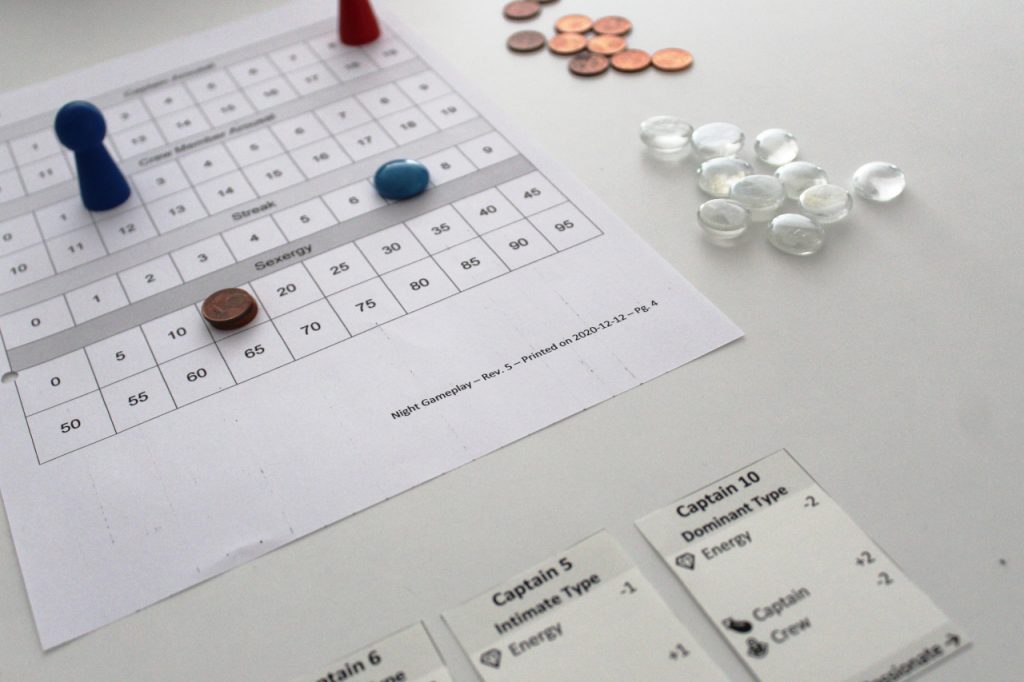
Paper prototyping is about making your game ideas playable as fast as possible. This allows you to catch mistakes that would have been very expensive to correct later on. It also means that you can get a feel for the gameplay without relying on artists or programmers. Paper prototyping is about using a game engine that runs on your own creativity.
I’ve written previously about how you can build your own paper prototyping kit. Now I want to show you how I actually use my kit to design games both big and small. I designed a new card game for Up There They Love, my adult visual novel and character management sim.
A distinct lack of sexy

My sexy game had a pretty big problem. The most consistent feedback I received on the builds was that people were wondering where the sex would come in. It turned out that my sexy game about sexing it up in space… didn’t actually have any sexy gameplay. The sex was supposed to fit between the existing gameplay systems, but I hadn’t actually designed it yet.
Up There They Love is structured like a visual novel with the character management layered on top. I tell the story through the visual novel, but the character management is the main gameplay loop. During character management, the player assigns crew members to different tasks on their spaceship.
Tasks can have positive or negative outcomes, depending on the luck of the draw. When tasks go well, characters gain Motivation, which is fed into the sexy gameplay. You can date characters with high Motivation at night, which is of course where the sex will happen.
Short-circuiting a design
As you can probably tell, I’m focusing on only a portion of my entire game design. That is on purpose. A key insight for me, being relatively new to game design, is that you can and should short-circuit your design. But what does that mean?
I already know that my Dating gameplay fits in between the Visual Novel and Character Management aspects of my design. Previously, I could treat it as a black box:
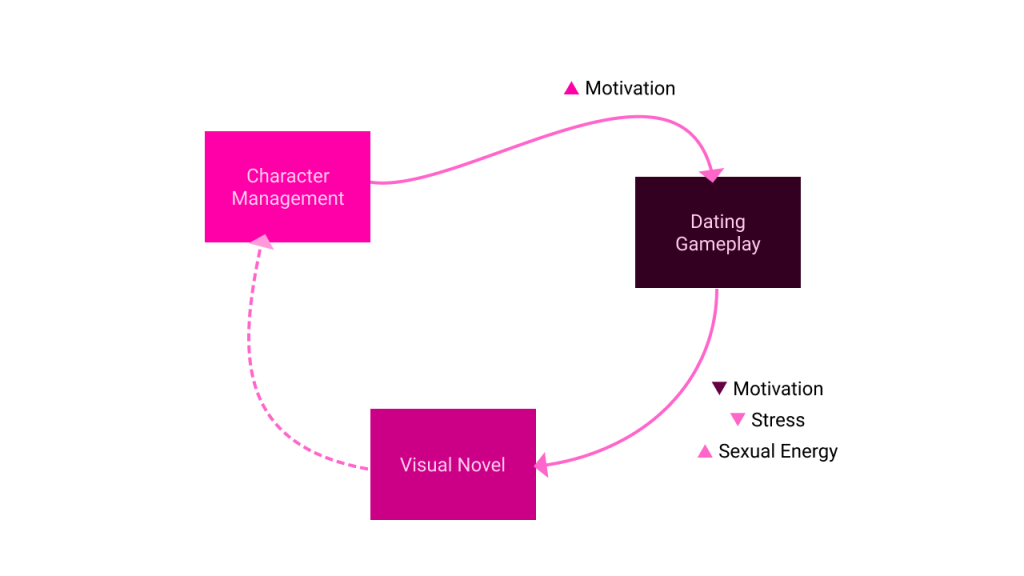
Characters with high Motivation go in, an effect on their Stress and Sexual Energy comes out. This is all I needed to know in order to tie it into the rest of the design. I can also give the characters a random effect on Stress and reward some Sexual Energy with relative ease. The reason I want to do this is that it frees me up to worry about the Dating gameplay later.
Isolating a smaller game
But now that I actually want to design the Dating gameplay, I can also inverse that relationship. Instead of treating the Dating gameplay like a black box with inputs and outputs, I can also treat the rest of the game like a black box.
Now the Dating gameplay can be treated as if it were a stand-alone game:
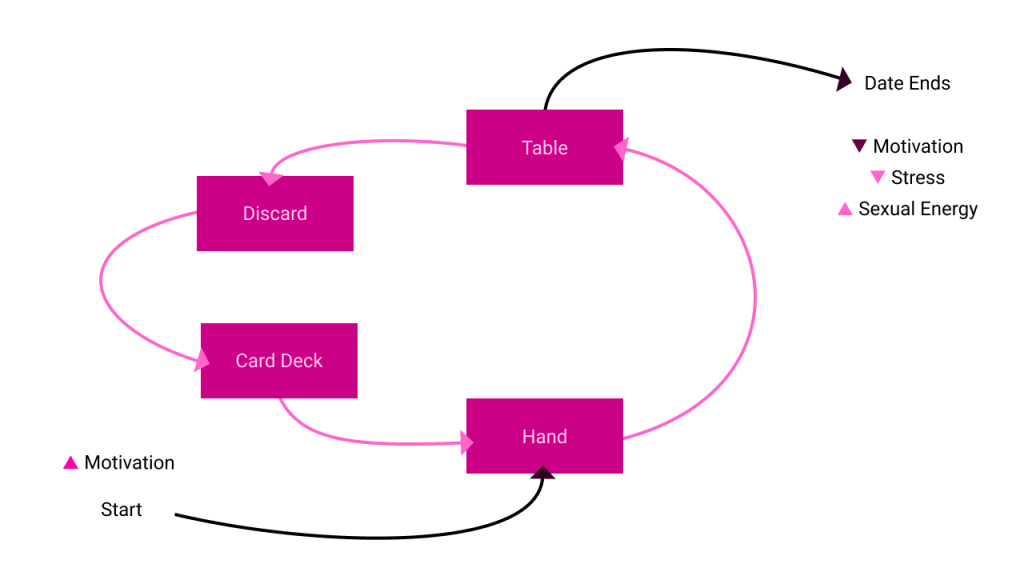
The goal of this much smaller game is to play multiple rounds of cards against an AI opponent. You win when you can raise their Arousal meter before they can raise yours. Winning in fewer rounds and fewer cards played earns you more Sexual Energy, so that’s how you can keep track of how you’re doing.
Divide and conquer
With the Dating gameplay separated out, I no longer have to worry about how it ties into the other parts of the design. I am simply playing a game against an AI opponent that has a winning or losing outcome. This means that I can focus on making the Dating gameplay awesome on its own without worrying too much about how it will fit into the rest of the design.
If you’re struggling with trying to design your entire game at once, give either of these methods a try!
- Short-circuit – Treat a part of your design as a system with randomized outcomes
- Isolate – Build a part of your design as a stand-alone game with a very small scope
Playing with the computer
When I set out to fill this gap in my gameplay, I knew I wanted to do things differently than other games. Sex is often treated as a reward for the player in adult games. And that’s fine, but it often comes at the detriment of character development. When done improperly it can feel like you have to convince or even manipulate the characters to have sex with you.
I’ve written before about how I want to avoid that type of game design for my own game. So for the dating gameplay, I set out to create a cooperative experience. Even though you’re playing against a computer, it should feel like you’re exploring a connection between two equal partners.
What I wanted to avoid was a competitive game in which you attempt to dominate the other party. It should also not be a slog to play and remain interesting on repeat plays.
To summarize my goals:
- Explicitly sexy
- Cooperative gameplay with an AI partner
- 2-5 minutes of repeatable gameplay
There are lots of ways to achieve these goals, but I decided that I wanted to try making a card game. I was already using a card metaphor on the character tasks and I thought it would be nice to extend that further to the dating gameplay as well.
Making a card game
With these goals in mind, I started designing my own card game using paper prototyping. It’s always best to start simple, you can make it more complicated later. So I started by giving two players a hand composed of playing cards, with values ranging from one to five.
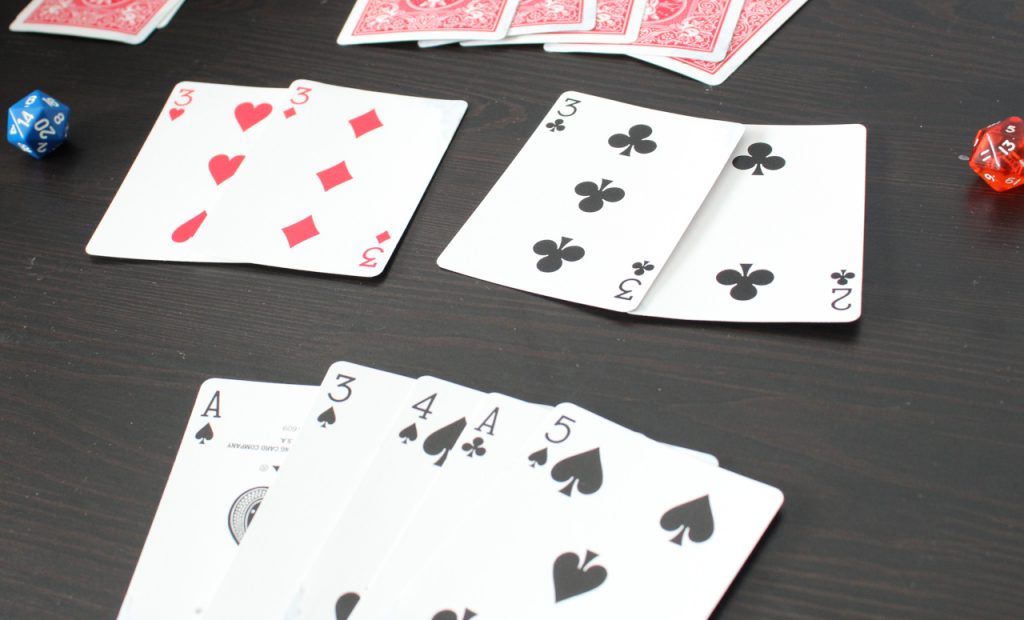
To play the game, you add the value of a card to your partner’s Arousal bar when you put it down on the table. When a player’s Arousal bar is full, they achieve Orgasm. You win the game if they achieve Orgasm before you do. It was a simple and straightforward design.
And also dreadfully dull.
Dissecting the frog
In game design, just like in comedy, it’s sometimes important to dissect why things go wrong. This kills the metaphorical frog but provides a lot of valuable insight.
Obviously, this prototype wasn’t very interesting to play, but let’s find out why. Your goal as a player is to raise the other’s Arousal bar. The only way for you to do that is by playing cards. Therefore, your incentive is to play as many cards as possible with as high of a face value as possible. And because there are no rules limiting you, the winning strategy is to play your entire hand immediately.
Since the cards in your hand are randomly drawn from a deck, their values don’t really matter. The game is purely based on luck: you win if your cards happen to be higher.
This won’t do at all. But now that we know what the problem is, we can try to address it. Would it help to make the cards more distinct?
Adding some flavor
My fix was to give the cards a type as well as a value, which is used in a rock-paper-scissors system. The three types of cards are Dominant, Passionate, and Intimate. Each type is about a different kind of love that I think naturally lends itself to contrasts.
For example, I can imagine a dominant opening move being countered with a passionate response. It makes the game feel a bit less abstract and allows me to insert some narrative flavor into the cards.
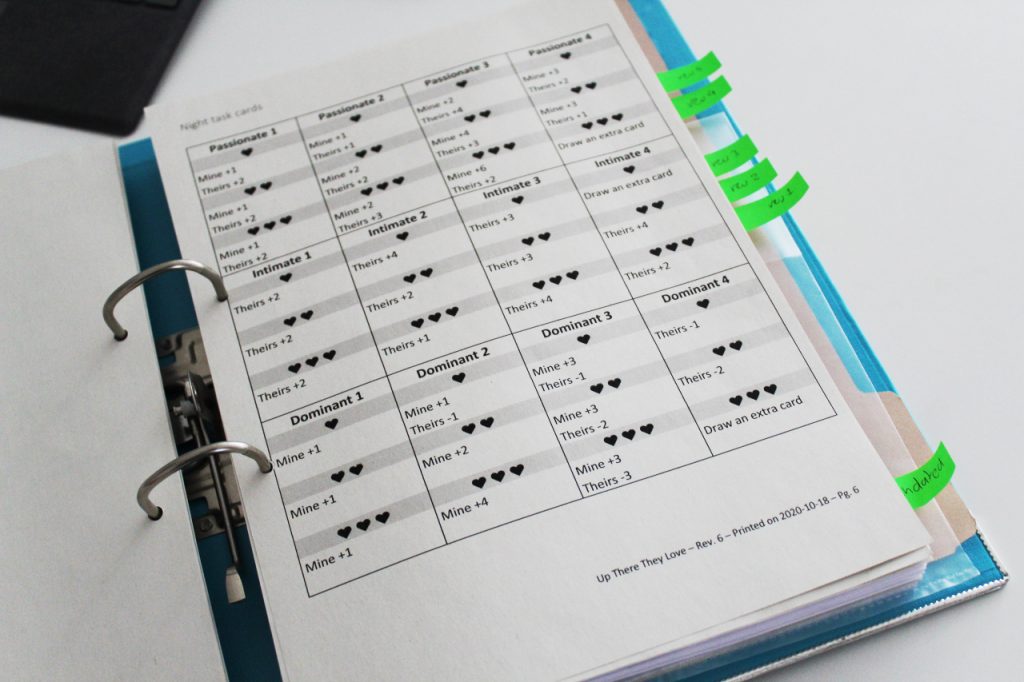
I initially had the idea to tie the card effects to different levels of the Arousal bar. Playing the same card would have a different effect depending on how far you were in the game. A friend pointed out that by adding three different effects to the cards, I had in effect tripled the number of cards in the game.
This is unfortunately one of those issues that won’t be immediately surfaced by a paper prototyping session. You’ll only find out much later when you’re actually trying to balance the cards. So this feedback was very much appreciated!
Playing with an actual designer
When I felt I had done enough paper prototyping by myself, I organized a playtest with a good friend of mine. He’s a former colleague and an actual game designer who now works at a much cooler company. I value his advice very much because he often has a better grasp of what I’m trying to do than I do myself.
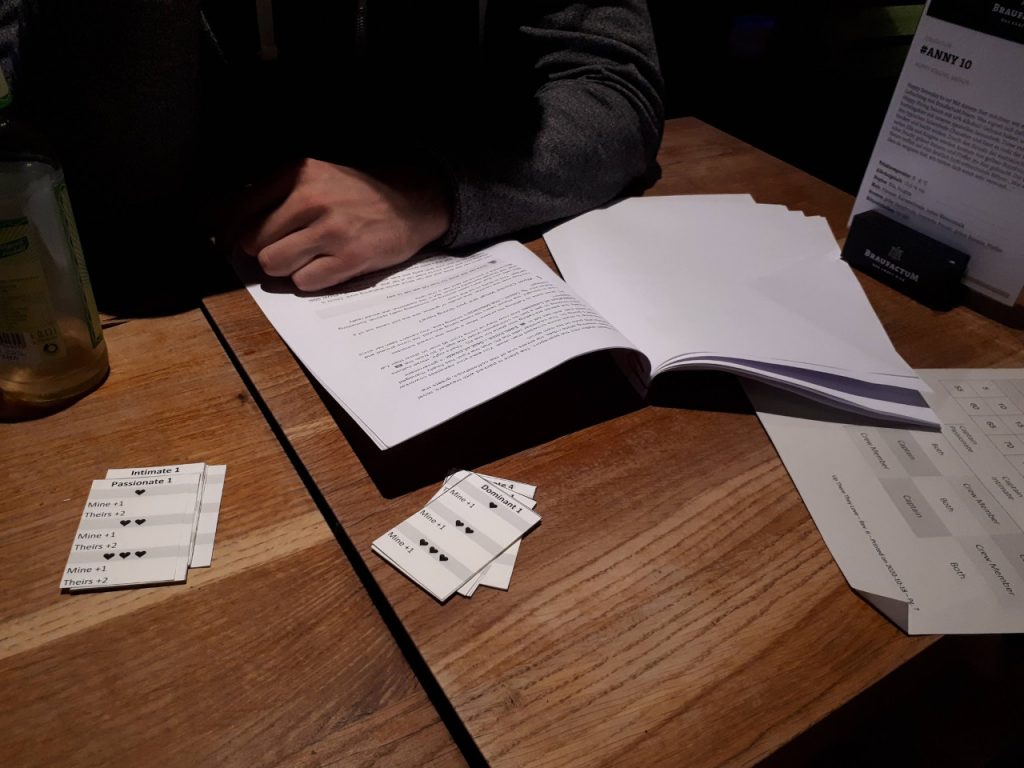
Although my game is single-player only, you’re still playing against an AI-controlled character. When doing paper prototyping, it can be helpful to have a human player act as the other character. When playing with my friend, I took the role of the AI-controlled Crew Member while he was the Captain.
In the version of the game I played with my friend, the cards had a type but not much else. They could affect either your partner’s Arousal or your own. And as I mentioned before, they would have different effects depending on how far the Arousal bar was filled.
After explaining the rules and handing out cards, I took notes while we played. And he immediately did something unexpected.
How my friend played
The Crew Member always has the opening move, so I played an Intimate 1 card from my hand. This would raise the Captain’s Arousal meter by 2 if his card type matched with mine.
But my anonymous friend instead played a Passionate 3 card, which raised my Arousal meter by 4 and his own by 2. Because Passionate beats Intimate in this version of the game, only the effects from his card were applied.
Next, I played a Passionate card of my own, which the Captain countered with a Dominant one. Again his card beat mine due to the mismatching types, but now his card was stronger as well. Because my Arousal meter was already at 4, the effects of his card were doubled.
There was no coming back after that. He would always counter my plays and with every win, his cards became more powerful.
After he’d won the game, he pointed out how I had inadvertently designed a game about dominating the other player. It makes logical sense to always go for the action that gives you the highest gains. But this is antithetical to the design goal of cooperative play. Simply put: there was no incentive in my design to work with the AI-controlled player towards a shared goal.
Luckily, he gave me some great advice on how to address these issues. His main suggestion was to introduce a streak mechanic.
Streaks
The streak starts at 1 and is used as a multiplier for the face value of the cards. The streak affects both players, which means there’s an incentive to keep it going. It also nudges you towards playing cards that aren’t necessarily the best play for you.
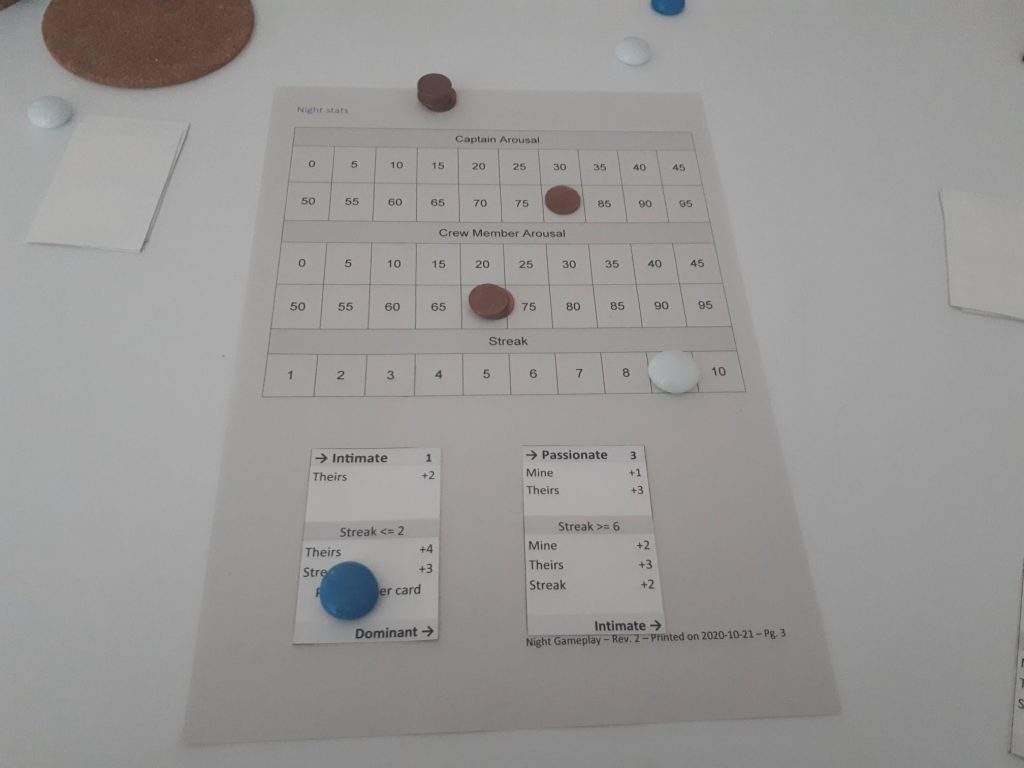
I also tied the streak into the card types themselves. Cards now have a type of their own and one they want to connect to. When the next card has the correct type, the streak keeps going. Otherwise, it’s reset to 1.
For example, when you play a Passionate card you will want to connect it to an Intimate card. However, you’re now only allowed to play a single card each turn. Keeping the streak going now falls unto your partner. In this example, the streak is reset if they don’t play an Intimate card from their own hand.
Card effects
After a few more iterations, I settled on a design where the player has five cards in their hand. Each card has an associated energy cost and the player can play as many cards in their turn as they have energy left. Any cards not played in their turn are discarded.
Cards can have one or more effects:
- Increase the Arousal of the Captain
- Increase the Arousal of the Crew Member
- Affect the Streak positively
The streak turned into “Heat”, which is used as a bonus for the card effects. At the start of their turn, the player ideally plays a card that connects to the mood of their AI-controlled partner. If not, the Heat bonus is reset.
The AI uses a simple algorithm to determine what card to play next. It focuses on keeping the streak going while trying to play as many cards as possible. There are probably some balance issues there, but those can be addressed later.
I played this prototype against myself and I thought it was pretty fun! There are now plenty of opportunities in each turn to interact with the other player. It no longer feels like you’re engaging in Sexual Combat but instead like you’re trying to pick up what the other party is putting down.
And it only took… 8 paper prototypes!
Paper prototyping saves you time and money
In order to keep things moving along, I skipped over many iterations of my design in this article. Suffice to say that I have a literal binder of rejected designs for this particular card game.
But what I hope you take away from my musings here is that paper prototyping is both cheap and effective. My first idea for the card game was playable within ten minutes of me picking up a deck of cards. This made it quick to see the flaws in the design and do another iteration.
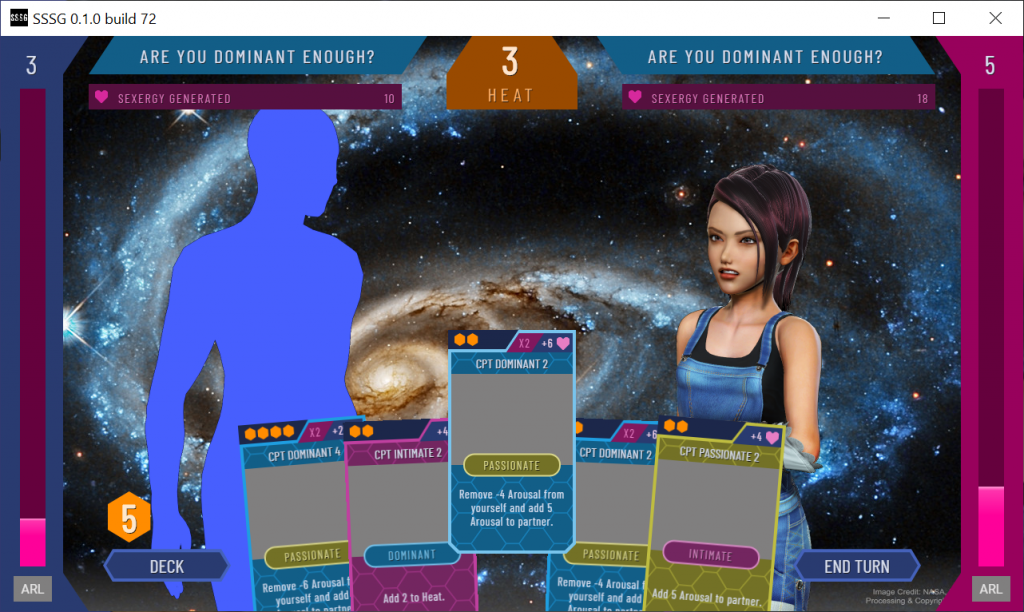
Now imagine if I had implemented the initial design in a game engine before testing it on paper! It would have meant weeks of engineering time just to reach the same conclusion. This is how paper prototyping saves time and effort: the faster you have something playable, the easier it is to make a decision about whether the idea is viable.
Conclusion
Of course, not all game ideas can be tested on paper. But often you can find out if the broad strokes of your idea will work. In a future article, I will dive into how I turned this paper prototype into a digital one.
Have you used paper prototyping to test out your ideas? Let me know how it went in the comments!